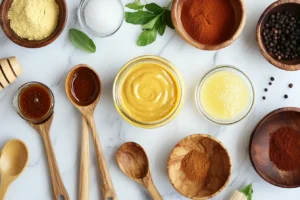Mustard BBQ sauce has a special place in the world of barbecue. It’s tangy, slightly sweet, and bursting with a bold mustard flavor that’s simply irresistible. Originating from the heart of South Carolina, this mustard-based BBQ sauce has become a favorite for its unique twist on traditional tomato-based sauces. Whether you’re grilling, dipping, or experimenting with recipes, this sauce is a game-changer. In this article, we’ll dive into the history, ingredients, preparation, variations, and ways to use this incredible sauce. Let’s get started with the rich history of mustard BBQ sauce!
Part 1: Introduction to Mustard BBQ Sauce
The Origins of Mustard-Based Barbecue Sauces
When you think of barbecue sauce, the first thing that probably comes to mind is a smoky, tomato-based concoction. However, mustard BBQ sauce is a southern staple with deep roots in South Carolina. It stands out not just for its golden hue but for the story behind its creation.
Historical Background
This tangy delight owes its origins to German immigrants who settled in the Carolinas. These settlers brought with them their love for mustard, which soon became the foundation for this iconic sauce. Unlike the heavily sweetened sauces of other regions, mustard BBQ sauce highlights the bold flavors of yellow mustard combined with subtle sweetness and a zing of vinegar.
South Carolina’s Influence
In South Carolina, barbecue isn’t just a meal; it’s a tradition. The region’s passion for slow-cooked meats perfectly complements the vibrant tang of mustard BBQ sauce. This sauce pairs particularly well with grilled or smoked meats, making it a household favorite at gatherings and cookouts.
Regional Variations
The beauty of mustard BBQ sauce lies in its adaptability. Different regions add their twist, incorporating more sweetness, heat, or smokiness depending on local tastes.
Comparison with Tomato-Based Sauces
Unlike traditional barbecue sauces, which often rely on ketchup or tomatoes for their base, mustard BBQ sauce provides a lighter and tangier profile. Its flavor doesn’t overpower the food but enhances it, allowing the smoky or grilled elements to shine.
Popularity in Southern Cuisine
Today, mustard BBQ sauce isn’t limited to the Carolinas—it has fans all across the country. From casual backyard BBQs to upscale restaurants, it’s celebrated for its versatility and boldness.
Part 2: Key Ingredients and Their Roles
Essential Components of Mustard BBQ Sauce
 Every great recipe starts with the right ingredients, and mustard BBQ sauce is no exception. This bold, tangy sauce depends on a blend of pantry staples and flavorful additions to create the perfect balance of sweetness, acidity, and spice. Let’s break down the key components that make this sauce stand out.
Every great recipe starts with the right ingredients, and mustard BBQ sauce is no exception. This bold, tangy sauce depends on a blend of pantry staples and flavorful additions to create the perfect balance of sweetness, acidity, and spice. Let’s break down the key components that make this sauce stand out.
Yellow Mustard
Yellow mustard is the heart and soul of this barbecue sauce. Its vibrant color, tangy flavor, and smooth consistency make it the ideal base for the recipe.
Flavor Profile
Unlike Dijon or spicy brown mustards, yellow mustard has a mild tanginess and a touch of sharpness, which form the backbone of this sauce. Its simplicity allows other ingredients to shine while still adding a zesty punch.
Why Yellow Mustard is Preferred
Yellow mustard’s smooth texture blends effortlessly with other components. It also maintains the sauce’s traditional golden color, which is a hallmark of South Carolina barbecue sauces.
Sweeteners
To balance the tanginess of mustard, sweetness is essential. This ingredient creates a delightful contrast that keeps your taste buds engaged.
Honey vs. Brown Sugar
Honey adds a natural sweetness and a slight floral note, while brown sugar brings a deeper, molasses-like flavor. Depending on your preference, you can use either—or a combination of both—for a sauce that’s perfectly balanced.
Balancing Sweetness and Tanginess
The trick is not to overpower the mustard’s boldness. A little sweetness goes a long way, ensuring the sauce stays tangy without being cloying.
Acids
Acidity plays a crucial role in enhancing the sauce’s complexity. It cuts through the richness of grilled or smoked meats and adds brightness.
Apple Cider Vinegar
Apple cider vinegar is the go-to choice, offering a tangy yet slightly sweet flavor that complements the mustard base. Its fruity undertones also elevate the overall taste.
Alternative Vinegars
White vinegar can be a good substitute if apple cider vinegar isn’t available, though it lacks the subtle sweetness.
Flavor Enhancers
Finally, it’s the little extras that give mustard BBQ sauce its signature depth.
Worcestershire Sauce
This savory, umami-packed ingredient adds richness and complexity to the sauce. Just a splash is enough to make a big difference.
Hot Sauce and Spices
A touch of hot sauce brings heat, while spices like garlic powder, smoked paprika, and cayenne add layers of flavor. These small additions make the sauce more dynamic and versatile.
Part 3: Step-by-Step Preparation Guide
Crafting the Perfect Mustard BBQ Sauce
Making a mustard BBQ sauce recipe from scratch is simpler than you might think! With just a few ingredients and some basic steps, you can create a sauce that tastes like it came straight from South Carolina. Let’s dive into the process to help you make a flavorful, smooth, and tangy sauce.
Gathering Ingredients
Before you begin, it’s important to have all your ingredients ready and measured out. Preparation is key to ensuring the process runs smoothly.
Measuring and Preparing Components
First, measure the yellow mustard, apple cider vinegar, sweeteners (honey or brown sugar), Worcestershire sauce, and spices. Lay everything out so you won’t need to stop mid-recipe. By doing this, you save time and avoid missing any crucial ingredients.
Mixing Process
Once you’ve gathered the ingredients, it’s time to mix them together.
Achieving the Right Consistency
In a medium-sized bowl, combine the yellow mustard, apple cider vinegar, and your chosen sweetener. Then, whisk these together until they’re smooth and fully blended. At this point, the mixture should have a creamy texture without any lumps. Add Worcestershire sauce and spices, and whisk again to ensure all the flavors meld.
Cooking Instructions
 Cooking the sauce enhances its flavors, so don’t skip this step!
Cooking the sauce enhances its flavors, so don’t skip this step!
Simmering Techniques
Pour the mixture into a saucepan and place it over low to medium heat. Stir occasionally to prevent sticking, but don’t let the sauce come to a boil—it should only simmer. This allows the flavors to develop and meld without burning the mustard. Simmer for about 10-15 minutes, or until the sauce thickens slightly.
Avoiding Common Mistakes
Keep an eye on the heat, as high temperatures can cause the mustard to break down, leaving an unpleasant texture. Additionally, taste-test the sauce as it cooks and adjust the seasoning if needed.
Storage Tips
After the sauce is ready, let it cool before storing it. Proper storage will keep your sauce fresh and flavorful.
Refrigeration and Shelf Life
Transfer the sauce to a clean, airtight jar or container, and store it in the refrigerator. When refrigerated, mustard BBQ sauce can last up to two weeks without losing its vibrant flavor.
Freezing Options
If you’d like to make a larger batch, freezing is an excellent option. Pour the cooled sauce into freezer-safe bags or containers, leaving some room for expansion. Thaw it in the refrigerator overnight before using it again.
Part 4: Variations and Customizations
Tailoring Mustard BBQ Sauce to Your Taste
One of the best things about mustard BBQ sauce is how versatile it can be. While the classic recipe is already amazing, you can easily tweak it to match your personal preferences. Whether you want a sweeter finish, a spicier kick, or a smokier undertone, there are plenty of ways to customize this sauce.
Adjusting Sweetness Levels
Not everyone has the same sweet tooth, so adjusting the sweetness is one of the simplest ways to personalize your sauce.
Using Molasses or Maple Syrup
If honey or brown sugar isn’t cutting it, you can experiment with molasses for a deeper, slightly bitter sweetness or use maple syrup for a smoother, earthy flavor. Both options complement the tangy mustard base beautifully and create a unique flavor profile.
Enhancing Spiciness
If you prefer a sauce with a bold kick, don’t hold back on the heat!
Incorporating Different Peppers
Add finely minced jalapeños, crushed red pepper flakes, or even a dash of cayenne to amplify the spice. For a smoky heat, try chipotle powder or a splash of your favorite hot sauce. Just be careful to add heat gradually, tasting as you go, so the spice doesn’t overpower the mustard’s tangy character.
Adding Smoky Flavors
Sometimes, you want a sauce that brings a subtle, smoky undertone to your grilled dishes.
Smoked Paprika and Liquid Smoke
Smoked paprika is a fantastic way to add a natural, smoky flavor without overwhelming the sauce. Alternatively, a small amount of liquid smoke can create that barbecue essence. Be sure to use liquid smoke sparingly—it’s quite concentrated and can quickly dominate the other flavors.
Experimenting with Herbs and Spices
For a truly unique mustard BBQ sauce, don’t be afraid to get creative with herbs and spices.
Rosemary, Thyme, and Other Additions
Fresh herbs like rosemary or thyme can add an unexpected herbal note to the sauce. If you’re feeling adventurous, sprinkle in a bit of ground coriander, turmeric, or mustard seeds for added texture and complexity. These tiny adjustments can elevate your sauce to new heights, making it completely your own.
The Perfect Sauce for Everyone
While the classic mustard BBQ sauce recipe holds its own, these variations allow you to tailor it to your preferences, ensuring it complements every dish you pair it with. Plus, experimenting with different flavors can turn a simple recipe into an unforgettable crowd-pleaser!
Part 5: Culinary Applications
Pairing Mustard BBQ Sauce with Dishes
Now that you’ve mastered the mustard BBQ sauce recipe, it’s time to explore the many ways you can use it. From classic barbecue staples to creative pairings, this tangy, golden sauce is incredibly versatile. Whether you’re grilling, roasting, or dipping, mustard BBQ sauce has the potential to transform any dish into something extraordinary.
Grilled and Smoked Meats
One of the most traditional uses for mustard BBQ sauce is as a companion to grilled or smoked meats.
Pork, Chicken, and Beef
Mustard BBQ sauce pairs beautifully with chicken, beef, or even ribs. Its tangy flavor cuts through the richness of smoked meats, making it the perfect glaze or finishing sauce. For instance, brush the sauce onto chicken thighs during the last few minutes of grilling to create a glossy, caramelized finish. Likewise, it works wonders as a marinade for steak, ensuring each bite is packed with flavor.
Vegetarian and Vegan Options
Surprisingly, mustard BBQ sauce isn’t just for meat lovers. It’s a fantastic addition to plant-based dishes as well!
Grilled Vegetables and Tofu
Grilled vegetables like zucchini, bell peppers, and portobello mushrooms benefit from the tangy kick of mustard BBQ sauce. Toss them in the sauce before grilling or serve it as a dipping sauce on the side. For a heartier vegetarian option, brush the sauce onto slices of tofu or tempeh and grill until lightly charred.
Sandwiches and Burgers
This sauce also shines when used to enhance your favorite sandwiches and burgers.
Pulled Pork Sandwiches
Mustard BBQ sauce is practically made for pulled pork sandwiches. Its tangy, slightly sweet flavor complements the tender meat perfectly, creating a well-balanced bite. Add a dollop of coleslaw on top, and you’ve got a southern classic.
Veggie Burgers
For veggie burgers, mustard BBQ sauce provides a bold punch of flavor. Spread it on the bun or use it as a dipping sauce for extra flair. Its zesty profile pairs well with ingredients like black beans, quinoa, or sweet potatoes.
Dipping Sauce Uses
Don’t underestimate this sauce’s potential as a simple dip.
Chicken Fingers and Fries
Serve mustard BBQ sauce alongside crispy chicken fingers or fries for a tangy alternative to ketchup or ranch. Its versatility ensures it works just as well with fried appetizers as it does with hearty barbecue dishes.
Unlocking New Culinary Possibilities
No matter how you use it, mustard BBQ sauce has the power to elevate your meals. Its tangy-sweet profile complements a wide variety of dishes, allowing you to experiment and find new favorites. Plus, its bright flavor adds a unique twist that you won’t find in typical tomato-based sauces.
Part 6: Nutritional Information and Considerations
Health Aspects of Mustard BBQ Sauce
While mustard BBQ sauce is undeniably delicious, it’s also worth considering its nutritional profile. By understanding its ingredients and making thoughtful adjustments, you can enjoy this sauce without straying from your dietary goals. Let’s explore what makes this sauce a flavorful yet manageable addition to your meals.
Caloric Content
Mustard BBQ sauce is relatively low in calories compared to richer, cream-based sauces. However, the calorie count depends on the sweeteners and fats included.
Serving Size Analysis
A typical serving, about two tablespoons, contains roughly 40-50 calories. If you’re mindful of portion sizes, you can enjoy the sauce without significantly impacting your daily calorie intake. It’s perfect for adding flavor without overindulging.
Sugar and Sodium Levels
While the tangy, sweet flavor of mustard BBQ sauce is irresistible, it’s important to monitor the amount of sugar and sodium used in your recipe.
Impact on Dietary Restrictions
For those following a low-sugar or low-sodium diet, the honey, brown sugar, or Worcestershire sauce might need to be reduced or replaced. You can also opt for low-sodium mustard and vinegar to make the sauce more heart-healthy.
Allergen Information
Since mustard BBQ sauce is primarily made from common ingredients, it’s generally allergy-friendly. That said, always double-check your ingredient labels.
Common Allergens in Ingredients
Worcestershire sauce often contains anchovies, which could pose a problem for individuals with seafood allergies. Some store-bought mustards may also contain additives that aren’t suitable for everyone. When in doubt, making the sauce from scratch is the best way to avoid allergens.
Making Healthier Substitutions
Small changes to the recipe can help make this sauce even healthier while maintaining its signature flavor.
Low-Sugar and Low-Sodium Alternatives
Swap out sugar for a natural sweetener like stevia, or try reducing the amount of sweetener altogether. For a lower sodium option, use a reduced-sodium Worcestershire sauce or eliminate it entirely, relying on spices like smoked paprika or garlic powder to add depth.
Why It’s a Smart Sauce Choice
Compared to many store-bought barbecue sauces, mustard BBQ sauce stands out as a lighter, tangier option. Its bold flavor allows you to use less without sacrificing taste, making it a practical choice for those watching their calorie or sugar intake.
Part 7: Frequently Asked Questions (FAQs)
Addressing Common Inquiries
As versatile and unique as mustard BBQ sauce is, you might still have a few questions about how to store, customize, or use it effectively. Let’s answer some of the most common queries to ensure your experience with this sauce is smooth and rewarding.
How long does homemade mustard BBQ sauce last?
Homemade mustard BBQ sauce can typically last up to two weeks when stored properly. To ensure its freshness, keep it in an airtight container or jar and refrigerate it immediately after it cools. Always use a clean spoon when serving to avoid contamination, which could reduce its shelf life.
Can I use Dijon mustard instead of yellow mustard?
Absolutely! While yellow mustard is traditional for its mild tang and bright color, Dijon mustard can work as a substitute if you prefer a sharper, more complex flavor. Keep in mind, however, that using Dijon may alter the sauce’s texture and slightly change its overall balance.
Is mustard BBQ sauce gluten-free?
In most cases, mustard BBQ sauce is gluten-free, but it’s crucial to check the labels of the ingredients you use. Some Worcestershire sauces and mustards may contain traces of gluten due to additives or cross-contamination during manufacturing. If you need to ensure it’s gluten-free, choose certified gluten-free brands or make substitutions where necessary.
How can I make the sauce less tangy?
If the tanginess is too strong for your taste, balancing it with additional sweetness or richness can help. Adding extra honey, brown sugar, or even a small dollop of natural yogurt can mellow the acidity. Alternatively, reducing the amount of vinegar used in the recipe will tone down the tang.
What dishes pair best with mustard BBQ sauce?
This sauce complements a wide range of dishes, from grilled chicken and pulled pork to roasted vegetables and veggie burgers. It’s especially popular as a marinade for proteins or as a finishing glaze for barbecued meats. Additionally, it’s fantastic as a dipping sauce for fries, chicken fingers, or even soft pretzels.
Can I can or preserve mustard BBQ sauce for long-term storage?
Yes, you can! If you want to preserve your homemade sauce for a longer period, consider canning it using proper home-canning techniques. Sterilize your jars, seal them tightly, and follow guidelines for safe water-bath canning to extend the sauce’s shelf life.

